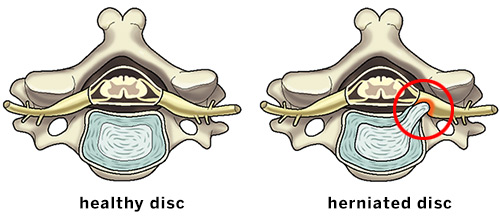Discectomy
A discectomy is a form of spinal decompression surgery to treat a herniated disc (sometimes called a "slipped disc"). A herniated disc occurs when a piece of a spinal disc bulges or ruptures and slips out of place, which can put pressure on a spinal nerve. This, in turn, may cause neck pain, back and/or leg pain (as may be felt in sciatica), leg weakness, leg numbness or cauda equina syndrome.

Illustrations of the axial (overhead) view of a healthy disc and a herniated disc putting pressure on a spinal nerve.
How does a discectomy work?
In a discectomy, damaged parts of a herniated disc are removed to relieve pressure on spinal nerves and alleviate pain. There are various methods and approches for performing this type of surgery. The choice of which is appropriate may depend on your specific condition and anatomy, as well as other factors. Learn more from the articles below.
Articles on discectomy procedures
Learn about various methods and surgical approaches for discectomies, including those performed in conjunction with a spinal fusion.
- ACDF Surgery: Anterior Cervical Discectomy and Fusion
- Microdiscectomy: Surgical Treatment for a Herniated Disc
- Spine Surgery: Minimally Invasive Lumbar Discectomy / Percutaneous Disc Removal (PDR)
- Lumbar Fusion
- ALIF Surgery: Anterior Lumbar Interbody Fusion
- PLIF Surgery: Posterior Lumbar Interbody Fusion
Articles on conditions treated with a discectomy
Learn more about herniated discs, which may not always require surgery.
Articles topics related to discectomy
Learn more about back pain and possible nonsurgical alternatives to a discectomy.
Discectomy Success Stories